The release of Midjourney v5 in March 2023 marked a moment in time when people realized that you can make photorealistic images with a text-to-image AI model. Compared to Midjourney v4, this iteration of the model showed a huge improvement in realism.
While I have seen countless people online saying that it's easy to spot an AI generated image, I don't believe this is the case. You might be able to do it for most AI generated images, but some images are so good that they'll fool even the people who pay close attention to the details.
How can you tell if an image is AI generated?
You can almost always find some details in an image that will show whether it was generated by artificial intelligence. As of right now, one of the easiest ways to do it is to pay attention to fingers (if there are any) and shadows in the images. You'll usually find something off there. But, it's hard to tell which details will appear strange, so you'll have to overall pay attention to the details to have a chance of determining if an image is AI generated.
There have already been several cases of AI images fooling millions of people. The most famous one included an image of what the Verge dubbed as a swagged-out pope. A more recent example showed AI images of Selena Gomez at the Met Gala, which also fooled countless people online.
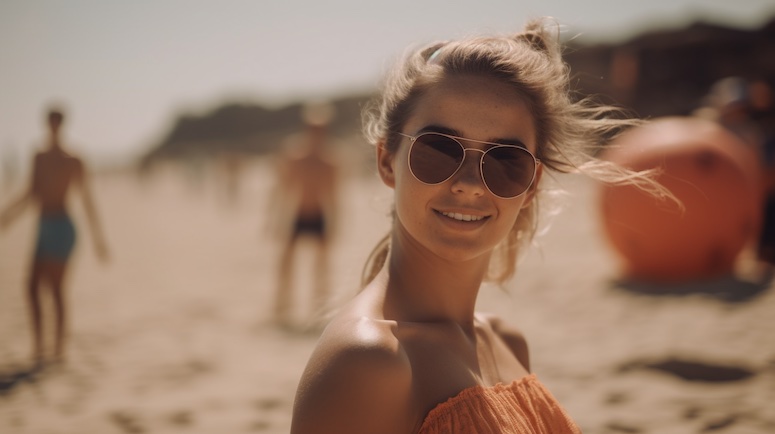
Can you tell if this image was generated by AI?
Whether or not AI generated images can easily be spotted is not an important topic right now even though it's an incredibly popular one. My argument is that the technology will get there sooner or later, and it will become extremely hard to distinguish real images from those that were generated by AI.
Well, that was quite the intro.
I felt like the whole question of whether or not you can spot AI generated images with 100% accuracy was something that should be discussed in this article. But make no mistake - the purpose of this article is to teach you how you can generate photorealistic images in Midjourney. I'll also share some prompts for realism you can try out.
Cameras and Focal Lengths
Before I show you Midjourney prompts for realism, there are some things that you absolutely must know if you want to generate high-quality photorealistic images. If you spend time in the Midjourney public Discord server, you're bound to notice that some people include a specific camera model or a focal length when they're writing prompts for photorealistic images.
Including information like camera models and focal lengths in your prompts can be incredibly helpful when you want to generate photorealistic images.
Here is a short list of camera models that you can include in your prompts:
- Canon EOS R5
- Canon EOS R6
- Canon EOS 5D Mark IV
- Sony A7R III
- Sony A9
- Sony A6000
- Sony A6400
- Fujifilm X-T4
- Nikon D850
- Nikon Z7
Now, let's talk about focal lengths. For instance, say you want to generate a photorealistic image of a person. You want it to be a portrait. Although you can use the word 'portrait' in your prompts, an even better technique is specifying the focal length. If we're talking portraits, the best focal length is 85mm.
You can also specify the following focal lengths - 35mm, 50mm, and 135mm.
If you're not too familiar with photography, a focal length is essentially the basic description of a photographic lens. It is expressed in millimeters. By specifying a focal length in your prompts, you'll provide the AI model with information on how much of the scene you want captured, as well as how much magnification you want in the image.
In case you want to generate landscape images, the focal lengths you should mention in your prompts can be 14mm, 18mm, 21mm, and 24mm.
Specifying camera models and focal lengths in Midjourney prompts may seem like a small detail, but it's extremely helpful. Using this information in your prompts will make the images appear more real. Let's see how it works on some prompt examples.
Midjourney Prompts for Realistic Portraits
In this section of the article, I will provide you with a few examples of how you can write Midjourney prompts for realistic portraits. If you want to learn more about how to write good prompts in general, I suggest you read an article I wrote recently in which I shared my framework for prompting in Midjourney.
Now, let's start with a relatively simple Midjourney prompt for a realistic portrait.
/imagine photorealistic portrait of a young woman with red hair, shot with Canon EOS R5, 85mm lens, the woman is wearing a green dress looking directly into the camera, slight smile, gold earrings, charming --ar 2:3 --v 5
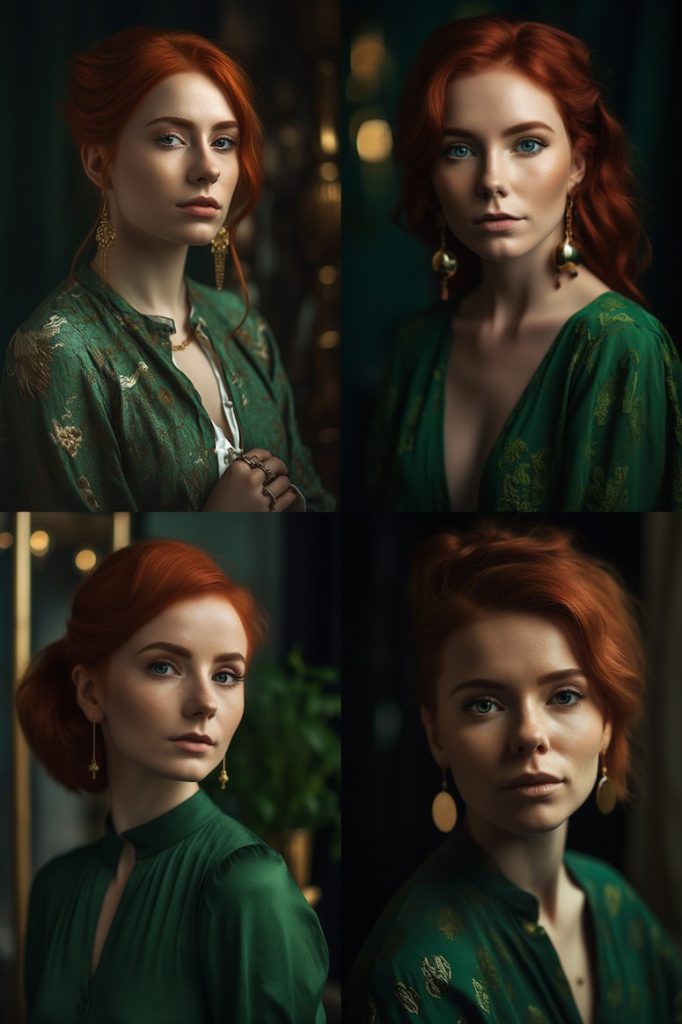
These images all look great, and I didn't even have to include a lot of details in the prompts. I would say that these would be easy to spot as being AI generated if you showed them to a random person. But I have to say that in my opinion, the one in the bottom right corner looks pretty real to me.
This was a fun little experiment, but let's try out a different prompt.
/imagine middle-aged man wearing a blue hoodie is standing next to his blonde wife, the man is looking directly at the camera, the wife is looking out into the distance, spring day at the park in the background, green trees, beautiful weather, couple in love, wholesome, happy, Sony A6000, 50mm lens --ar 2:3 --v 5
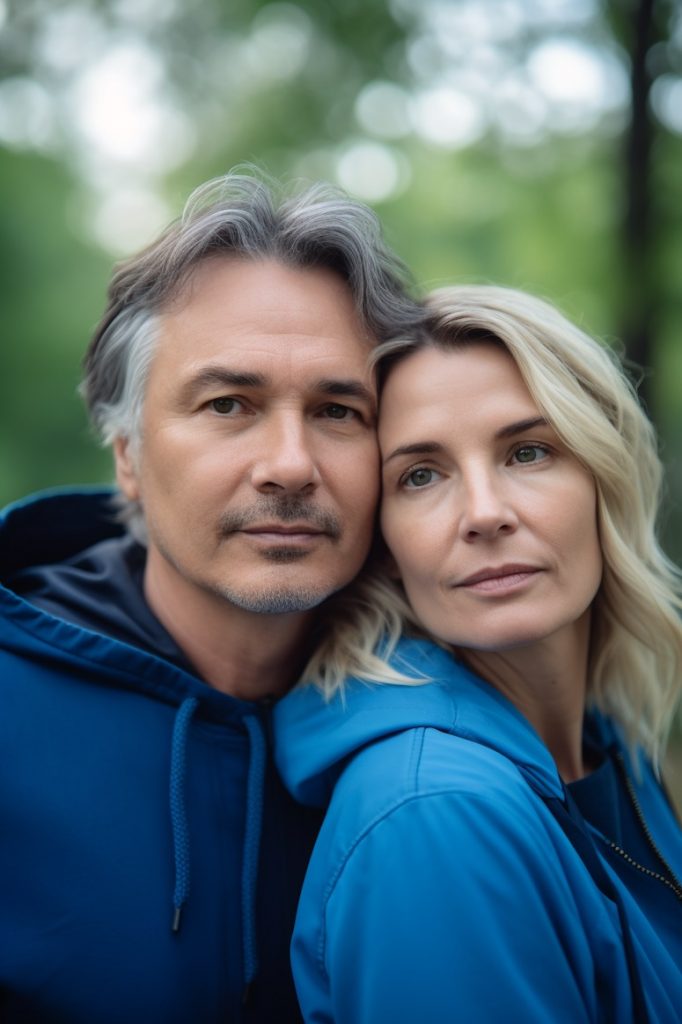
This image really stood out from the four that were generated, which is why I decided to post only it. Very good image of a beautiful couple that looks quite real. I'm quite impressed with this result.
One thing that I didn't do in these two prompts is specify a certain time period. That's why we're not about to time travel back to the 1970s with the next prompt.
/imagine 1970s, young African-American woman having fun at the disco, disco ball lights in the background, New York City, big smile, the time of your life, colorful dress, 1970s disco era, Canon F-1, 35mm lens --ar 2:3 --v 5
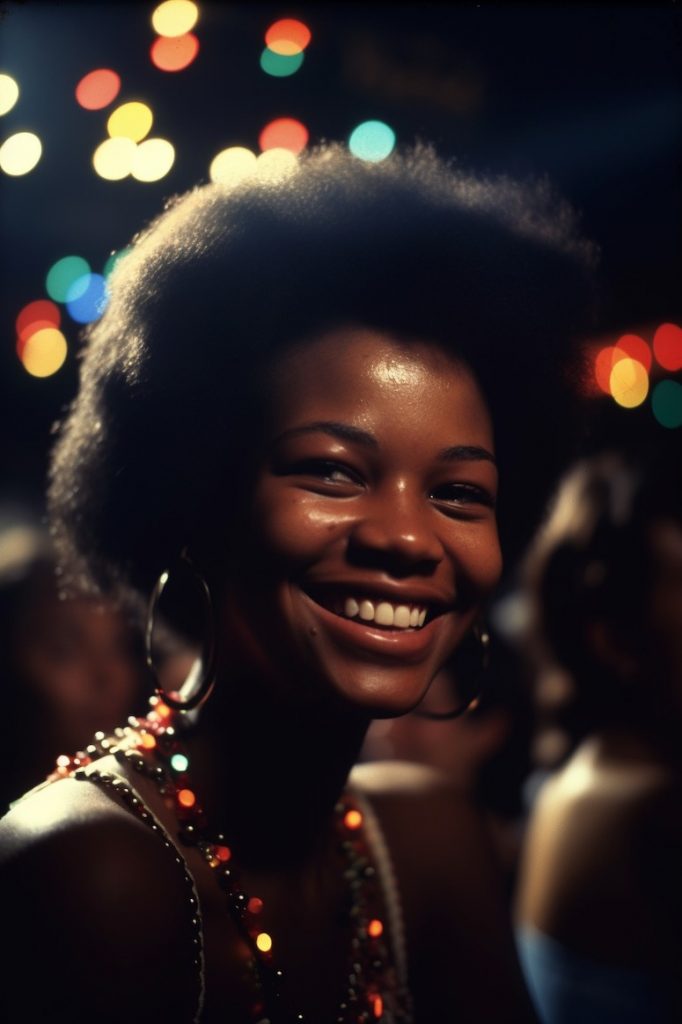
To get the effect that I wanted from this image, I had to specify a camera model that was popular during the 1970s. I picked a random model that came up after I did a quick Google search - Canon F-1. It seems like it was a great choice because this image looks like it's a photo taken during that decade.
You can feel free to experiment as much as you want with portraits. Travel back in time, try out different environments, write prompts that include people of different ages, etc. There are so many details you can change in prompts like these to generate amazing images.
Let's do one more and then we'll move on to prompts for realistic landscapes.
/imagine iPhone selfie, young couple at the coffee shop, relationship goals, happy couple, full of love, wholesome, spending time with your significant other, soulmates --ar 2:3 --v 5
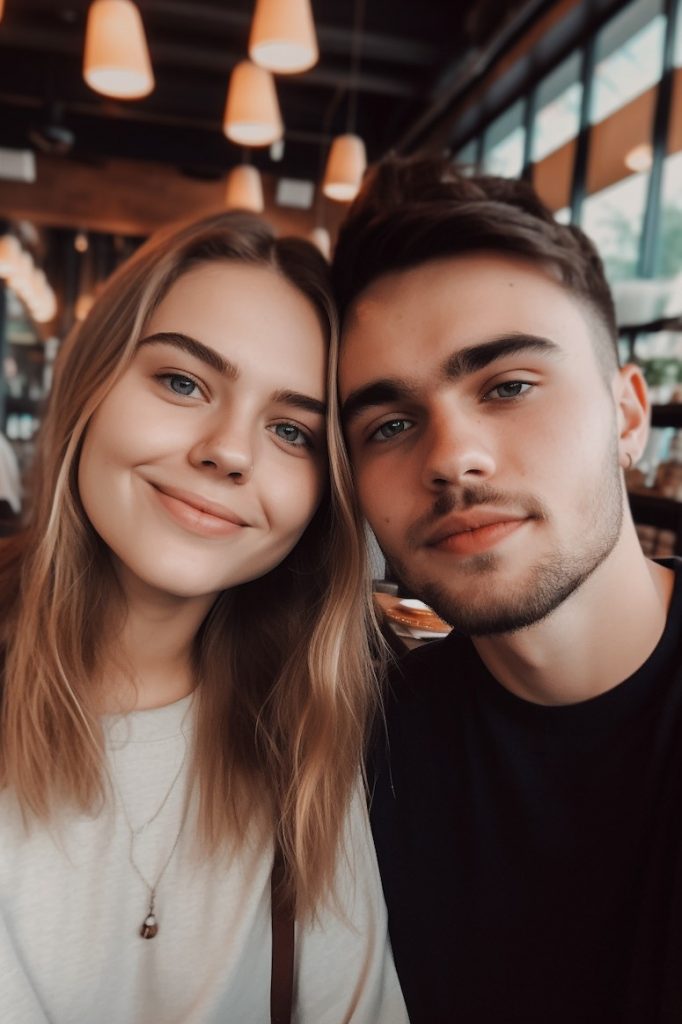
I wanted to do something a bit different here so that you can see just how much you can tweak your prompts. I wanted this image to look like it was a selfie taken on an iPhone, so that's the information I included in the prompt. I also included keywords like "relationship goals" which I think is a great choice here to get a good image of a young couple in love.
Midjourney Prompts for Realistic Landscapes
I want to show you how you can create realistic landscape images of nature in Midjourney. It's a similar process to the previous one when you get down to the essentials. You'll still need to specify both a camera model and a focal length, as well as include relevant keywords and choose an appropriate aspect ratio.
I'm already pretty warmed up, so let's get straight to it. Here's a prompt example for a beautiful, realistic landscape.
/imagine photorealistic image, Nikon D850, 14mm lens, Icelandic landscapes, snow that hasn't melted in months, green pastures, mountains in the background, beautiful nature, National Geographic, horses running out in the wild --ar 16:9 --v 5
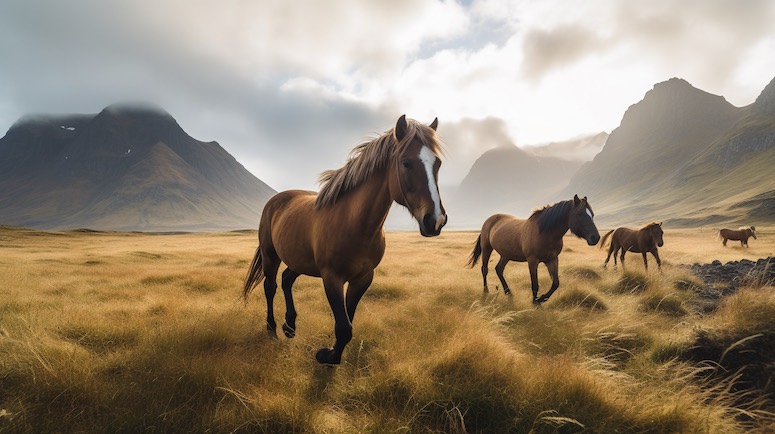
To get the effect that I wanted, I included what's known as a modifier in this prompt. The modifier is the "National Geographic" keyword. This is practically an instruction that I gave to the AI model to let it know I wanted the image to look like it was from a National Geographic magazine.
Let's move to a warmer climate and see what type of image we can generate.
/imagine Bora Bora, Canon EOS R6, 24mm lens, cinematic shot, overwater bungalows, beautiful resort, honeymoon destination, amazing day, great weather, sun is shining, clear water, insanely detailed, photorealistic --ar 16:9 --v 5
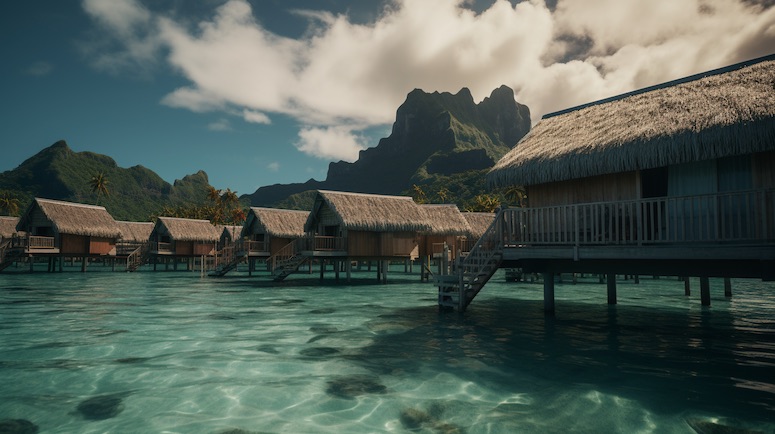
It's crazy how good this image is. I've never been to Bora Bora but I've seen photos online and if you were to throw this one randomly among the hundreds of photos on Google Images, I wouldn't be able to tell that it was generated by artificial intelligence.
Okay, I'll do one more prompt and then I have to wrap up this article.
/imagine Fjords of Norway, Fujifilm X-T4, 21mm lens, water, snow, small village, view from a cliff, daytime, amazing nature, wondrous, realistic, photograph, --ar 16:9 --v 5

If I had more free time on my hands, I would do a social experiment and start a travel blog or Instagram page where I'd only post AI generated images of various locations to see how many people would notice because these images are just that good.
Final Thoughts
It's not difficult to generate photorealistic images in Midjourney, but there are a few things that you should pay attention to when you're writing prompts. Some of the rules I follow when I'm writing Midjourney prompts for realism include:
- Specifying a camera model
- Specifying a focal length
- Choosing the right aspect ratio
- Adding relevant keywords
I also try to experiment with different details. I might try generating an image that looks like it's a photo taken during a certain decade. I also experiment with different settings to see how it may affect the image.
Regardless of whether you have experience prompting in Midjourney or not, you can start generating photorealistic images today. Simply follow the information provided in this article to start seeing extraordinary results!